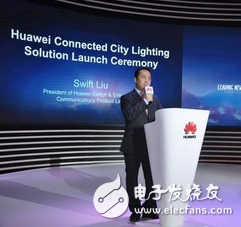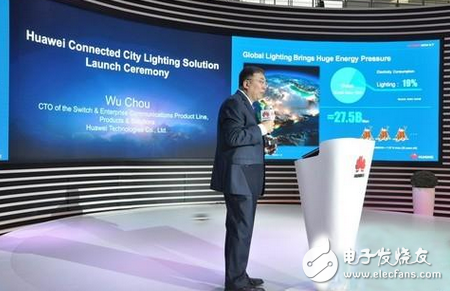On March 15, 2016, Huawei unveiled the industry's first multi-level intelligent control lighting IoT solution at CeBIT 2016 (Hanover Consumer Electronics, Information and Communication Expo), the world's largest ICT technology exhibition. The scheme integrates the urban lighting street lights into the IoT network and visually manages them based on GIS. The manager can clearly understand the status information of each street and each street lamp; by applying flexible lighting strategies, each street lamp can be used. The switch state and illumination brightness are precisely controlled to achieve on-demand illumination with energy efficiency up to 80%.

Speech by Liu Shaowei, President of Huawei Switch and Enterprise Communication Product Line
According to The Climate Group, the number of street lights in the world is about 304 million, and will reach 352 million in 2025. Streetlights everywhere in the city, while bringing convenience to people's lives, the huge energy consumption and high management costs of the city also make the city managers painstaking. In London, for example, street lighting consumes more than 56 million kilowatt-hours per year (according to The Climate Group, the number of street lights in London is about 35,000 baht. Based on 400W high-pressure sodium lamps), huge energy costs are added. Manual inspection and management and maintenance costs are a big expense for city managers. Huawei's lighting IoT solution will solve the problem for urban managers.

Huawei switch and enterprise communication product line CTO Zhou Wei released solutions
Lighting strategy "combination boxing" comes together to ensure high efficiency and energy saving
A street light controller is installed for each street light to control the switch and dimming. Different from the industry's use of streetlight access methods such as Wi-Fi, Huawei uses IPv6-based 6LoWPAN technology, which has low power consumption, self-discovery, self-organizing network, and can be self-healing quickly, and can be better and better. Sensors and other smart devices interact. In the control of street lamps, the lighting strategy has a set of "combination boxing", which can be calculated based on the local latitude and longitude. The lighting duration of different seasons, different months and even every day can be dynamically adjusted. It can also be combined with the built-in brightness sensor. Third-party traffic, human flow sensors, etc. are linked, or intelligently adjusted according to actual weather and environmental conditions. For example, when the traffic flow is scarce late at night, the brightness of the street lights is turned down, and the lights are turned on at intervals; in the rainy weather with poor lighting conditions, the lights are turned on according to the brightness perception. The Huawei solution is based on LED street lights and uses a combination of lighting strategies. Compared with traditional street lamps such as high-pressure sodium lamps, the energy-saving efficiency is as high as 80%.
Visual management, street lamp online inspection, failure failure prophet
The solution uses GIS-based visual management. One person can manage thousands of street lights in multiple blocks. The number of street lights, street lights, installation location, installation time and other information in each block is clear at a glance. When the street light fails, the system will automatically alarm and send a message to notify the maintenance personnel to repair it in time. The system can also manage the life cycle of street lamps, anticipate possible failures in advance, and achieve forward-looking maintenance. This management mode has changed the situation of relying on manual regular street inspections in the past, which not only saves labor costs but also improves management efficiency.
Multi-level intelligent control, multiple levels of protection, multiple layers of reliability
Traditional street lights generally use centralized control and cannot accurately control individual street lights. When the control network is faulty, it is not uncommon for many street lamps to appear "competing with the sun" during the day, resulting in waste of energy. Multi-level intelligent control is the biggest feature of Huawei's solution. It includes two levels of local intelligent control and one-level network intelligent control. Both the Agile IoT Gateway and the Street Light Controller can be equipped with lightweight agile planning components to support the localization of lighting strategies to form a two-level local intelligent decision-making mechanism. When the uplink network of the agile gateway fails, it can quickly switch to the local control strategy; when the 6LoWPAN sensor network fails, the streetlight controller can work completely offline and operate independently. Multi-level intelligent control minimizes the dependence of street lights on the control network.
Multi-level open, a total of painted smart city blueprint
Another major feature of the Huawei solution is the adoption of a full-level open architecture. The underlying control chip can be developed based on the open source lightweight operating system Liteos. Devices from different vendors can interact better based on unified standards; agile gateways support virtualization architecture, partners can develop and install customized applications; agile controllers It provides a standard northbound interface for third-party application systems, which facilitates the expansion of various service components, and achieves all-round linkage with intelligent transportation, environmental monitoring, and urban governance, providing first-hand big data for municipal management.

Huawei and partner ESL (Enika Smart Light as) jointly released lighting Internet of Things solutions
“Since Huawei released the Agile IoT solution in May 2015, it has gradually spawned many industry solutions such as power Internet of Things, intelligent buildings, and smart animal husbandry. Lighting Internet of Things is an agile IoT solution in the field of urban lighting. A successful practice. This program is an important part of the construction of smart cities. With the advancement of smart city construction, more sensory facilities can be added on the basis of lighting Internet of Things, environmental monitoring, traffic monitoring, intelligent charging. Various objects such as piles and smart trash cans are included in the perception network to provide basic data support for smart cities and expand more intelligent services.†Zhou Wei, CTO of Huawei switches and enterprise communication product line, said.
Vicpas for Panasonic Repair, Vicps for Panasonic Touch Screen Repair, Vicpas for Panasonic Touch Panel Repair, Vicpas for Panasonic HMI panel Repair, Vicpas for Panasonic interface panel Repair, Vicpas for Panasonic simatic panel Repair, Vicpas for Panasonic multi panel Repair, Vicpas for Panasonic GT01 HMI panel Repair, Vicpas for Panasonic smart line Repair, Vicpas for Panasonic GT01R Repair, Vicpas for Panasonic GT02M Repair, Vicpas for Panasonic GT02G Repair, Vicpas for Panasonic Operator panel Repair, Vicpas for Panasonic Sinumeric Repair, Vicpas for Panasonic GT03T-E Repair, Vicpas for Panasonic GT05 Repair, Vicpas for Panasonic GT11 panel Repair, Vicpas for Panasonic KP3C Repair. Vicpas for Panasonic Membrane Keyboard Repair, Vicpas for Panasonic membrane keypad Repair, Vicpas for Panasonic membrane switch Repair, Vicpas for Panasonic front cover Repair, Vicpas for Panasonic plastic shell cover Repair, Vicpas for Panasonic interface cover Repair,
For Panasonic HMI Touch Screen Repair
Panasonic Hmi Touch Screen Repair,Panasonic Touch Panel Repair,Panasonic Touch Membrane Repair,Panasonic Touch Glass Repair
GUANGZHOU VICPAS TOUCH TECHNOLOGY CO.,LTD , https://www.touchsuppliers.com